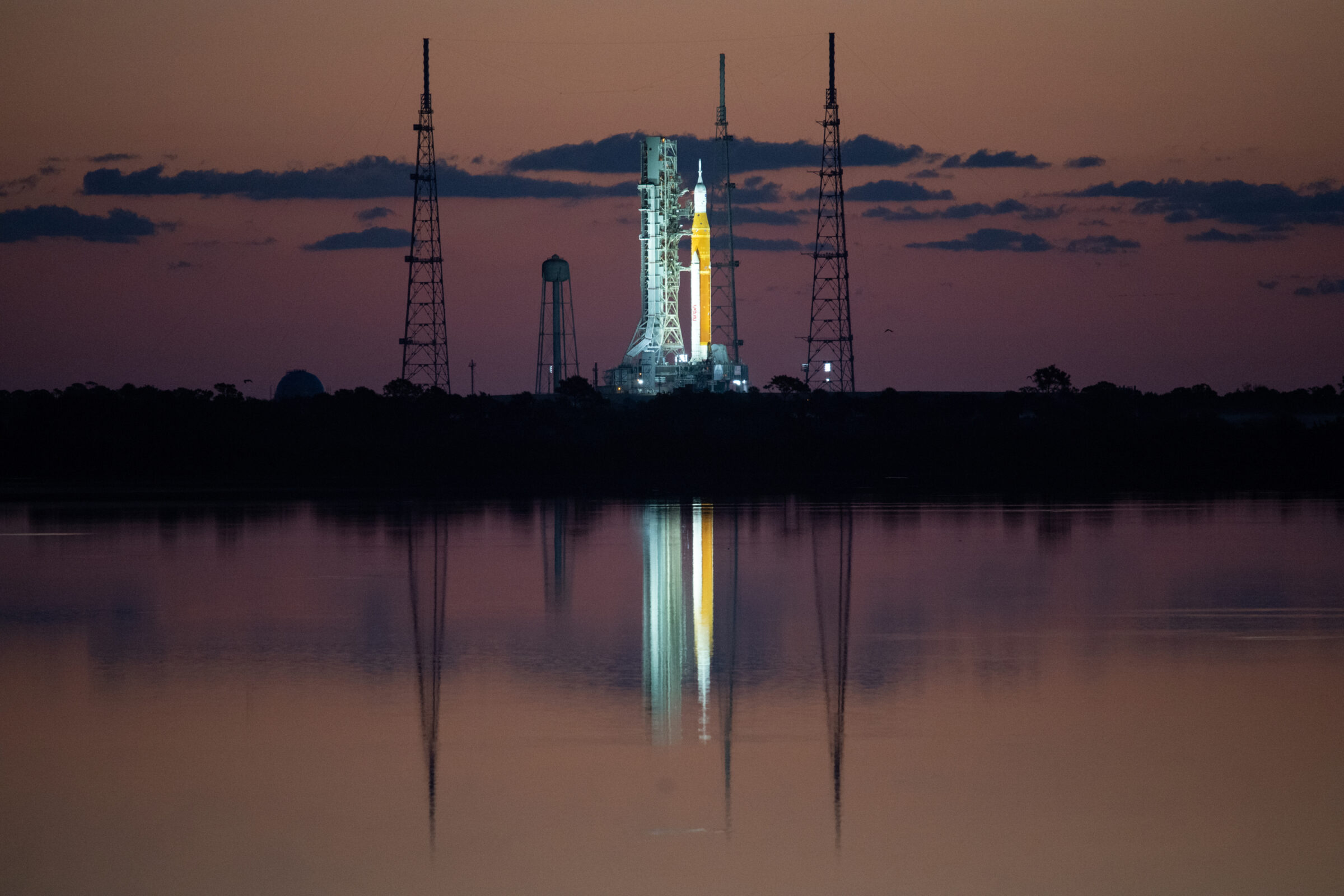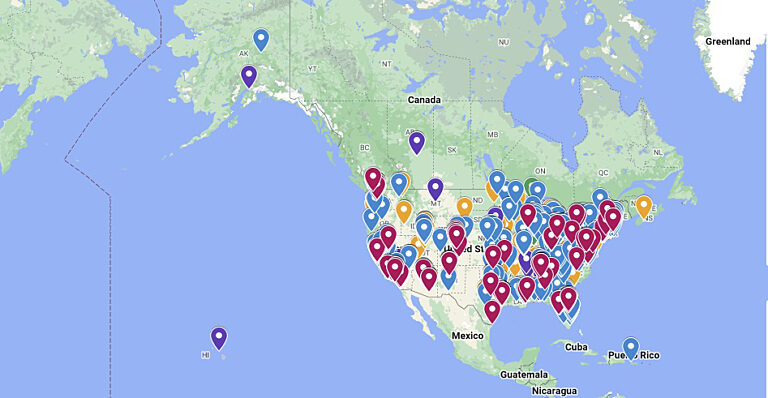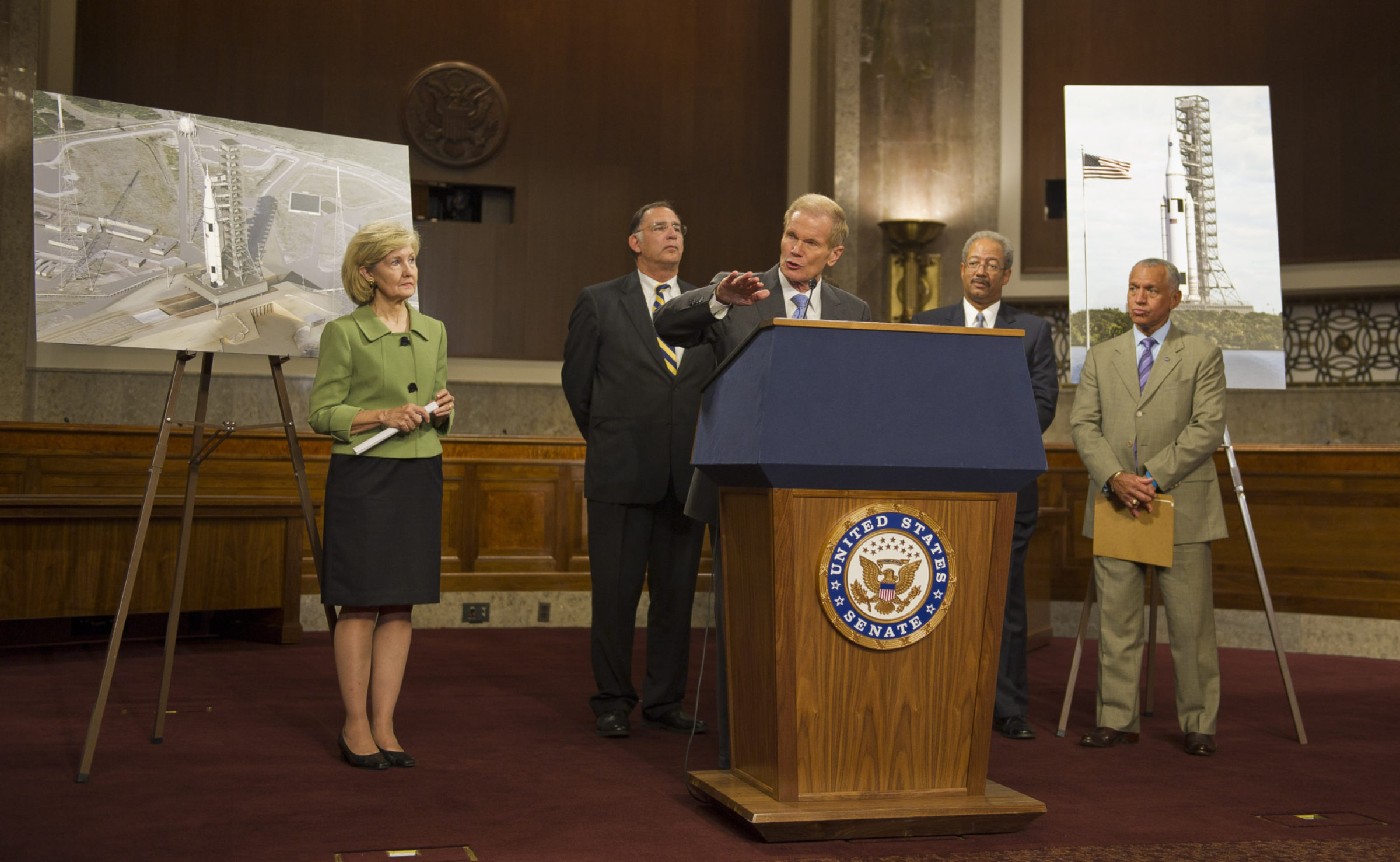Casey Dreier • Aug 03, 2022
Why we have the SLS
A broad political coalition creates enduring support for NASA's most powerful rocket
NASA’s massive Space Launch System (SLS) rocket has endured controversy since its creation in 2010.
A product not of NASA’s leadership but of congressional legislation, the SLS will be the space agency’s first human-rated, heavy-lift launch vehicle since the Saturn V. At its first launch, it will be the most powerful rocket in the world. However, SLS development has been undermined by serious cost overruns and schedule delays. Originally claimed to cost $6 billion and launch in 2016, the SLS will instead launch in 2022 after expenditures of more than $23 billion. The SLS is neither reusable nor cheap, costing between $876 million and $2 billion per launch, depending on how one accounts for its related overhead costs.
Given its cost, the existing launch capabilities provided by private companies such as SpaceX, Blue Origin, and RocketLab, and the real progress being made on a new generation of super heavy-lift private rockets, why does the SLS still exist?
The answer, of course, lies in politics. Depending on how you look at it, the SLS is either a product of a broken system that curries favor to wealthy industries or an example of representative democracy working as it should — with members of Congress responding to the local needs of their constituents. Perhaps it’s a bit of both. But there are real and durable reasons for why we have (and will continue to have) the SLS for many years to come.

Representative democracy incentivizes parochialism
The Space Launch System is a consequence of two characteristics of the U.S. political system: annual congressional disbursement of “discretionary” funding and distinct regional districts of federal representation. Together, these create a strong parochial incentive to drive federal funds into specific geographical locales around the country. Government funding creates jobs, improves local economies, and sustains high-profile, unique projects that would otherwise not exist in such communities. Lawmakers operate under the theory that economically secure constituents will generally vote to sustain the status quo, which bodes well for their reelection chances.
In addition, there are specific committees in Congress responsible for different oversight and funding of different parts of the government. The Appropriations Committee writes annual legislation that funds common federal activities, from national defense to housing subsidies, art funding to scientific research. This spending is considered discretionary (i.e. not a legal obligation or defined by a prior law that guarantees annual expenditures). Every year Congress must pass this legislation, or the functions of the U.S. government will grind to a halt.
NASA centers are distributed unevenly throughout the country. There are just a handful of them, and they generally receive hundreds of millions to billions of dollars annually. Not coincidentally, nearly every lawmaker with a NASA center in their state or district serves on a congressional committee that sets policy or funding levels for the agency. Locales with large NASA contractors, like Lockheed Martin (Boulder, CO) and SpaceX (Hawthorne, CA), also tend to have congressional representation on strategic committees. There are also literally thousands of subcontractors scattered around the country that receive funding from NASA projects, creating varying degrees of financial interest in their local representatives.

The SLS and Orion spacecraft projects are of such a scale that they spend money in all 50 states and Puerto Rico, creating parochial interest in nearly every congressional district. According to a 2019 economic impact report, these programs created approximately $14 billion in total economic output and supported more than 69,000 jobs nationwide. Maintaining these jobs is ultimately the foundation of the SLS/Orion political coalition in the United States.
The end of the Space Shuttle during the Great Recession led to the SLS
Having established the parochial nature of discretionary funding for NASA, it’s worth considering the historical context that led to the SLS.
After Apollo, NASA found itself with a declining budget and lacking political support for new projects. In 1972, the agency eked out Presidential approval to build a reusable space transportation system that would increase access to space and lower costs — the Space Shuttle. Notably, investing in the Shuttle also helped preserve aerospace jobs in California during the run-up to President Nixon’s re-election; he later won the state.
The first Shuttle launch didn’t happen until nine years later, in 1981. This began three decades of operations which sustained a massive, specialized workforce concentrated in Texas and Florida to service and maintain the complex spacecraft. The Space Shuttle, infamously, was never cheap nor reliable; historically, NASA spent approximately $4 to $5 billion (adjusted for inflation) per year in operations. This entrenched workforce helped maintain and protect the program, politically, for nearly 40 years.
But the 2003 Columbia disaster highlighted a fundamental design flaw of the Shuttle, and political support finally aligned behind a new path for NASA’s human spaceflight program. Initially, this was called Constellation, a deep space program comprised of the Orion crew vehicle and two Shuttle-derived rockets: a medium-lift rocket to access the space station and a new heavy-lift rocket to carry astronauts back to the Moon. The Shuttle would continue flying through 2011 in order to finish building the International Space Station.

At the start of the Obama administration in 2009, the Constellation program was in desperate straits. Under new leadership, NASA proposed to do away with Constellation, commit to new commercial partnerships to send crew and cargo to Earth orbit, and invest heavily in new technologies. The Shuttle program would end as planned.
The proposal could not have come at a worse time, economically. It was the nadir of the Great Recession. The coming end of the Shuttle program and the cancellation of Constellation (which incorporated much of the old shuttle contractors' workforce) would contribute to tens of thousands of job losses throughout the country, particularly in states with major human spaceflight centers.
In response, the U.S. Senate, led by Senators from Texas and Florida, passed the NASA Authorization Act of 2010, which rejected the full cancellation of Constellation by retaining the Orion crew vehicle and the heavy-lift rocket program, now called the Space Launch System. It directed NASA to leverage existing Shuttle and Constellation contracts to create the SLS, ensuring the continuation of extant funding streams and thousands of jobs.
It is not too much of a simplification to say that the SLS is the modern implementation of the Space Shuttle workforce.
The enduring political stability of the SLS
Despite cost overruns and ongoing delays, there has never been a serious political threat to the SLS from Congress or the White House. This is independent of whether Democrats or Republicans are in control.
In fact, Congress is generally eager to provide funding over and above the amount NASA requests for the rocket. Again, this is independent of which party controls Congress. This suggests a broad coalition is invested in the program; the SLS is not dependent on a single powerful lawmaker.
Consider the distinct appropriations bills drafted each year by the House and Senate. While the final bill represents a compromise between the two, each individual bill is exclusively the output of that chamber. The trend is clear: since its inception in 2012, both the House and Senate have added additional funds to the SLS program. Not just in some years, but in every single year of the program’s existence, regardless of which party controlled the chamber, and regardless of financial or schedule performance of the project:
| Fiscal Year | NASA Request | House Proposal | Senate Proposal | Final Appropriations |
|---|---|---|---|---|
| 2012 | $1,800 | $1,985 | $1,800 | $1,860 |
| 2013 | $1,340 | $1,857 | $1,482 | $1,415 |
| 2014 | $1,385 | $1,476 | $1,600 | $1,600 |
| 2015 | $1,380 | $1,600 | $1,700 | $1,700 |
| 2016 | $1,357 | $1,850 | $1,900 | $2,000 |
| 2017 | $1,310 | $2,000 | $2,150 | $2,150 |
| 2018 | $1,938 | $2,150 | $2,150 | $2,150 |
| 2019 | $2,078 | $2,150 | $2,150 | $2,150 |
| 2020 | $1,775* | $2,150 | $2,586 | $2,586 |
| 2021 | $2,257 | $2,600 | $2,586 | $2,586 |
| 2022 | $2,487 | $2,635 | $2,487 | $2,600 |
| Average Increase | $304M (+20%) | $317M (+21%) | $335M (+22%) |
All values in millions of dollars. Not adjusted for inflation. *In FY 2020, the Trump Administration submitted a supplemental budget increasing their SLS request to $2.286 billion. Source: Congressional CJS appropriations legislation for FYs 2012 - 2022.
From 2012 to its first launch in 2022, Congress added extra money to the SLS every year, providing a total of $3.7 billion in additional dollars to the SLS project.
Funding is a proxy for political priority — Congress can only spend a dollar once. The money regularly added to the SLS should be seen for what it is: a statement of deep and enduring congressional support. Otherwise, there would be more variability in funding outcomes.
Annual dollar obligations for NASA's SLS, Orion, and related Exploration Ground Systems, since their conception. Values not adjusted for inflation. Orion predates the start of the SLS as it was originally conceived for the Constellation program, which was canceled in 2010. Source: Human Spaceflight Program Budgets Dataset.
Looking beyond funding to official policy, congressional support can be measured by looking at NASA authorization legislation, which are the product of separate committees in the House and Senate composed of different lawmakers than those on appropriations. The results are similar: every NASA authorization bill since 2010 has endorsed the SLS and directed NASA to invest in the program.
This foundation for this broad coalition is the billions of dollars flowing to thousands of contractors in all 50 states and Puerto Rico. While a few states, such as Alabama and Florida, receive the bulk of the funds, many hundreds of millions of dollars are distributed throughout the country on an annual basis. And since loss aversion is a far stronger political motivation than abstract promises of future gains, the political coalition defending this system will generally be far stronger than any devoted to ending it.
The political quandary: if not the SLS, then what?
For many, it sounds like a straightforward argument: cancel the slow and outdated SLS and direct its $2.6 billion per year into novel public-private partnerships like SpaceX’s Starship, which promise to revolutionize access to space.
Now imagine this argument from the perspective of a congressional representative from Alabama, home of the SLS: first cancel the SLS and lay off tens of thousands of constituents, then take that money that had previously allowed their voters to have good incomes, mortgages, and a sense of pride from a high-status project and give instead to California and Texas, where SpaceX is located. You may get laughed out of the room.
This is the core dilemma for those who want to end the SLS: how do you make a politically viable alternative? The answer must involve building a new coalition that is stronger and more motivated than the one currently invested in the status quo. This tends to be quite difficult, and historically requires a major external event to predicate massive political change.
The SLS could suffer a catastrophic failure — that’s what ultimately ended the Space Shuttle program. Or maybe a series of dramatic political realignments will significantly reduce the influence of regions that most benefit from the current program. Or perhaps the incentives themselves could change. NASA has already transformed its approach to new programs through fixed-priced commercial partnerships that better control costs and reward performance.
However, none of these provide clear paths for those who wish to stand against the SLS. The reasons why NASA has the SLS remain far more compelling than the reasons not to have it. And meanwhile, on the eve of its first launch, NASA is readying a long-term contract securing upwards of 24 SLS rockets through at least 2036. The political support for the SLS remains steadfast and is likely to continue.
For those who find this distressing, consider this: the lawmakers that make up the SLS political coalition are zealously defending the interests of their constituents — and isn’t that the entire point of representative democracy? There is and will remain a tension in the U.S. political system between local and national interests. Ideally, local interests align with national interests. And until there is an alternative to the political dynamics that represent the foundation of the SLS coalition, perhaps the best path forward is to focus on making the program more efficient, more capable, and more effective in achieving its goals. Remember, at the end of the day, NASA is on the cusp of returning to the Moon. And what is a better incentive than having decades of Moon rockets in production, waiting to take us there?
Let’s Go Beyond The Horizon
Every success in space exploration is the result of the community of space enthusiasts, like you, who believe it is important. You can help usher in the next great era of space exploration with your gift today.
Donate Today

 Explore Worlds
Explore Worlds Find Life
Find Life Defend Earth
Defend Earth


